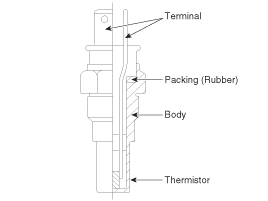 Kia Optima: CVVT Oil Temperature Sensor (OTS). Description and Operation
Kia Optima: CVVT Oil Temperature Sensor (OTS). Description and Operation
Description
Continuous Variable Valve Timing (CVVT) system advances or retards the valve timing of the intake and exhaust valve in accordance with the ECM control signal which is calculated by the engine speed and load.By controlling CVVT, the valve over-lap or under-lap occurs, which makes better fuel economy and reduces exhaust gases (NOx, HC) and improves engine performance through reduction of pumping loss, internal EGR effect, improvement of combustion stability, improvement of volumetric efficiency, and increase of expansion work.
This system consist of- the CVVT Oil Control Valve (OCV) which supplies the engine oil to the cam phaser or runs out the engine oil from the cam phaser in accordance with the ECM PWM (Pulse With Modulation) control signal,
- the CVVT Oil Temperature Sensor (OTS) which measures the engine oil temperature,- and the Cam Phaser which varies the cam phase by using the hydraulic force of the engine oil.
The engine oil getting out of the CVVT oil control valve varies the cam phase in the direction (Intake Advance/Exhaust Retard) or opposite direction (Intake Retard/Exhaust Advance) of the engine rotation by rotating the rotor connected with the camshaft inside the cam phaser.
 Installation
Installation
ŌĆó
Install the component with the specified
torques.
ŌĆó
Note that internal d ...
 CVVT Oil Temperature Sensor (OTS). Specifications
CVVT Oil Temperature Sensor (OTS). Specifications
Specification
Temperature [┬░C(┬░F)]
Resistance (kΩ)
-40(-40)
52.15
-20(-4)
16.52
0(32)
...
See also:
Engine compartment
2.4L Engine
2.0L Engine
1. Engine coolant reservoir 2. Engine oil filler cap 3. Brake/clutch* fluid
reservoir 4. Air cleaner 5. Fuse box 6. Positive battery terminal 7. Negative
battery term ...
Windows
(1) DriverŌĆÖs door power window switch (2) Front passengerŌĆÖs door power window
switch (3) Rear door (left) power window switch (4) Rear door (right) power
window switch (5) Window opening and ...
Panoramaroof Switch. Repair procedures
Inspection
1.
Disconnect the negative (-) battery
terminal.
2.
Remove the overhead console lamp
assembly.(Refer to the BD group - "Roof trim")
...
